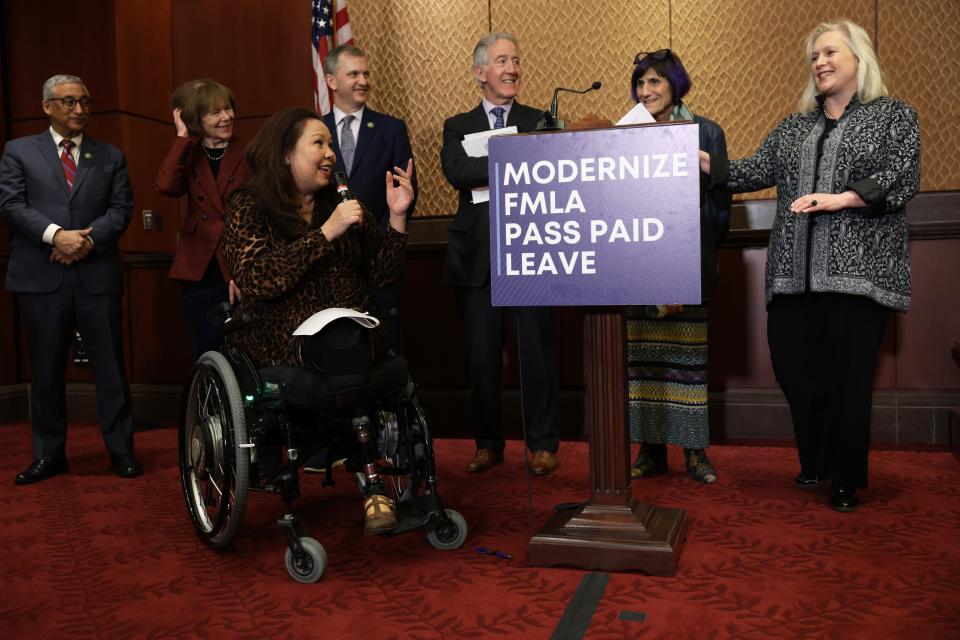Here's one federal mandate all Americans can love: Workers need paid family leave
- Oops!Something went wrong.Please try again later.
When the Family and Medical Leave Act became law 30 years ago this month, millions of workers in the United States won the right to take care of a medical or family need without fear of losing their job. But the historic law hasn’t aged well.
Through the prism of 2023, what FMLA really does is allow some workers to endure economic hardships – taking time off without pay – so that they can take care of themselves or the people around them during challenging times. The 1993 law’s shortcomings, alongside workers’ changing expectations, is strengthening the case for change. Paid leave has gained traction among voters on both sides of the political aisle, with 84% of people supporting a federally mandated policy.
It’s wildly popular everywhere – except on Capitol Hill.
The only industrialized country with no required paid family and medical leave
The United States has an opportunity in this Congress to create a benefit that most Americans want but too few have. President Joe Biden vowed in his State of the Union address to make paid family leave a legislative priority, and it might be one of the few issues on which Democrats and Republicans can agree.
U.S. should not be trailing: Let's use momentum to get paid parental leave for all families
Between my daughters and my mom: Why must we pick between paychecks and caring for loved ones?

Hours before the president’s speech, in fact, a bipartisan Task Force on Paid Family Leave – with three Democrats and three Republicans – met to kick off talks to explore a path forward. They have momentum on their side and can look to the states for answers: In those that have tried it, paid family and medical leave has been paying off for businesses, workers and the greater economy.
FMLA has given the nation a glimpse of the possible: a country in which everyone has the support they need to care for themselves and their families. About 15 million people in America use the policy each year for reasons ranging from having a baby to caring for a sick family member, a common case during the pandemic for women especially.
But nearly 11 million people who need leave don’t take it, with more than 7 million of them saying it’s because they could not afford it.
Today, the United States is the only industrialized country without federally mandated paid family and medical leave, an unflattering distinction.

Thirty years ago, the arguments against FMLA – none of which panned out – went something like this: It’s too expensive, will burden employers and harm the economy. Today’s arguments against universal paid family and medical leave center on whether small businesses can sufficiently navigate this new benefit for millions of workers, and who will pay for it.
But what if paid leave threaded the needle by helping employers hire and retain the workers they need while helping people with the burdens they often face?
11 states and Washington, D.C., have successfully implemented paid leave
The benefits of paid family leave are clear: It improves the health of mothers and babies, supports women staying in the workforce and helps businesses recruit top talent. At a time when employers are struggling to fill open positions, some of our most vital members of the workforce choose to stay home for reasons that paid leave could address.
Older and unappreciated: Workers over 50 face a rough time on the job
A reality check on U.S. workforce: Time to invest in people with disabilities
About 80% of U.S. workers don’t have access to paid leave. That means after having a baby, adopting a child, falling ill, or needing to care for a sick parent or child, most Americans can’t take time off work without risking their income or their health.
For so many women, workers in low-wage jobs, workers of color or workers with disabilities, this is an impossible and inequitable choice that has forced many to abandon the workplace altogether.
States, often the laboratories of innovation, have successfully implemented programs that Congress should consider in crafting federal policy. Eleven states and Washington, D.C., already guarantee the benefit, and the U.S. military for the first time this year began offering 12 weeks of paid parental leave to service members.
Opinions in your inbox: Get exclusive access to our columnists and the best of our columns every day
California, New Jersey and New York fund statewide paid family leave through a payroll tax that both companies and employees contribute to. Similarly, Washington, D.C.’s paid leave program is funded by a 0.26% employer payroll tax.
In California, 87% of businesses reported that state-mandated paid family leave did not increase costs, and 9% found that the program actually saved their companies money. Many companies reported saving that money on turnover expenses, which can cost an average of one-fifth of an employee’s annual salary.
That makes sense: When employees are content with their jobs and benefits, they’re less likely to leave. Businesses also found that when employees could take paid leave, they were less stressed and, in turn, more productive. That led to greater workforce participation, especially among women. Rather than hurt businesses, paid leave helped employers and employees thrive.
Opinion alerts: Get columns from your favorite columnists + expert analysis on top issues, delivered straight to your device through the USA TODAY app. Don't have the app? Download it for free from your app store.
A lot has changed since 1993, but the FMLA remains the same. It’s time to create a policy that reflects the needs of a modern workforce. Universal paid family leave could be the needed change that benefits both the employee and employer while also creating a healthier and more equitable society.
Thirty years later, paid family leave is no longer viewed as something nice to have, but a must-have benefit whose time has come.
Avenel Joseph is the vice president for Policy at the Robert Wood Johnson Foundation in Princeton, New Jersey.
You can read diverse opinions from our Board of Contributors and other writers on the Opinion front page, on Twitter @usatodayopinion and in our daily Opinion newsletter. To respond to a column, submit a comment to letters@usatoday.com.
This article originally appeared on USA TODAY: Paid family leave: American workers are still falling behind

